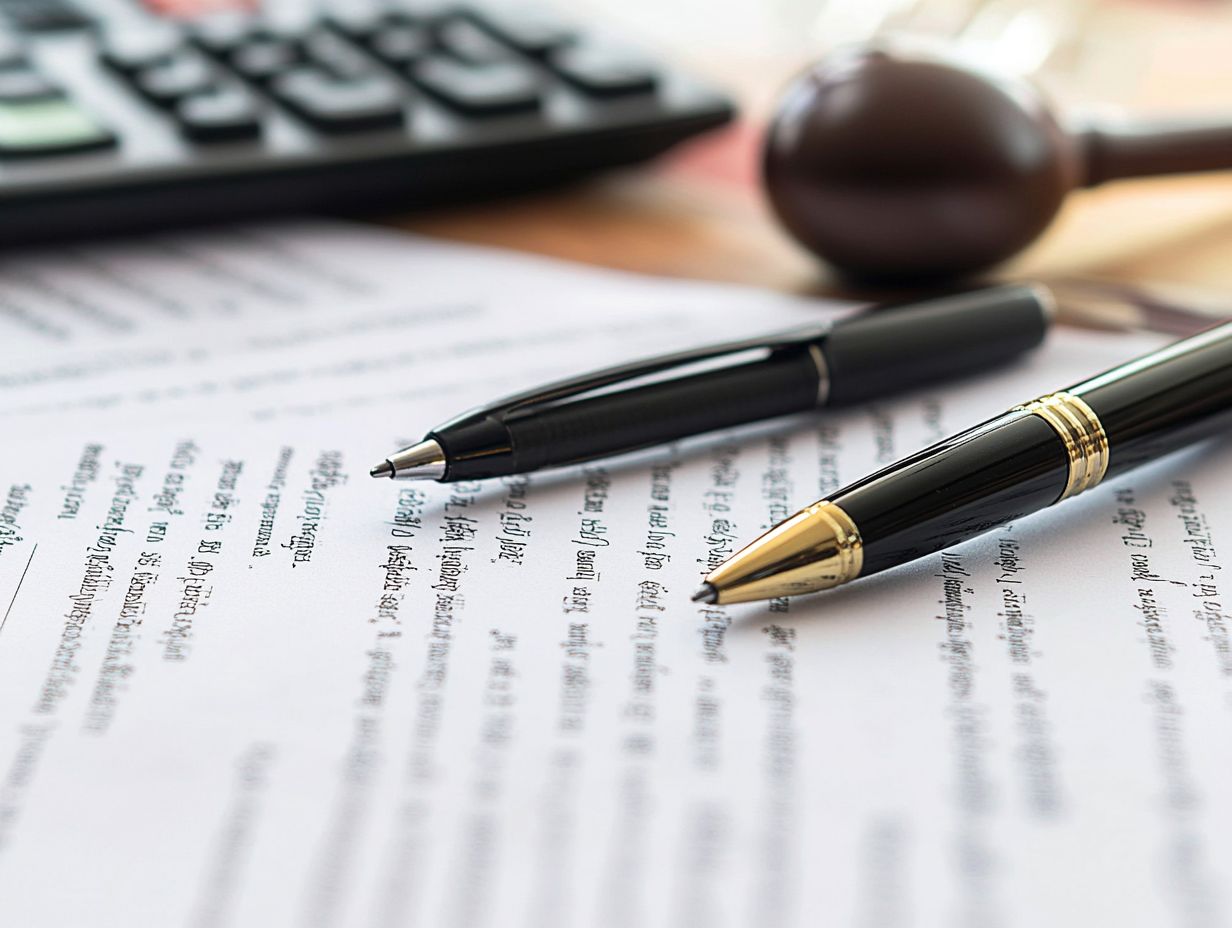What to Know About Liability Limits in Policies
Understanding liability limits in insurance policies is essential for anyone aiming to safeguard their assets and effectively navigate potential risks.
This article elucidates the definition and significance of liability limits, delves into the distinctions between occurrence and aggregate limits, and examines the factors that influence these limits such as industry standards and legal requirements.
The article also offers guidance on determining the appropriate liability limits tailored to your specific needs. It highlights common pitfalls to avoid and discusses how liability limits apply across various types of insurance, including auto, homeowners, and business policies.
Let s dive in and discover how to protect what matters most!
Contents
- Key Takeaways:
- Understanding Liability Limits in Policies
- Types of Liability Limits
- Factors Affecting Liability Limits
- How to Determine Appropriate Liability Limits
- Common Mistakes to Avoid with Liability Limits
- Liability Limits in Different Types of Policies
- Frequently Asked Questions
- What are liability limits in insurance policies?
- Why are liability limits important?
- How do I determine the right liability limits for me?
- What happens if I exceed my liability limits?
- Can I change my liability limits after purchasing a policy?
- Are the maximum amounts the same for all types of insurance policies?
Key Takeaways:

- Liability limits in policies are the maximum amount an insurer will pay for a claim. Choose limits based on your industry and potential risks.
- Assess your business needs and potential risks carefully. Avoid underinsuring or overinsuring for adequate coverage.
- Different policies, like auto, homeowners, and business insurance, have varying liability limits that require careful consideration.
Understanding Liability Limits in Policies
Understanding liability limits in insurance policies is essential for you as a homeowner, ensuring that your assets and personal property are well protected against potential financial risks.
Liability insurance, especially within homeowners insurance, serves as a critical line of defense against unexpected events. It s vital to ensure that your coverage limits are adequate to handle various situations, including bodily injury, property damage, and legal expenses.
Take the time to comprehend how these limits are determined by your insurance provider and their implications on your overall coverage, particularly when considering unique items or specific circumstances, such as a guest house.
Definition and Importance
Liability limits define the maximum amount your insurance company will pay for a covered loss under your homeowners insurance policy. These limits are essential for protecting your personal property and ensuring you have adequate coverage against various risks.
They play a pivotal role in determining your financial security, offering protection not just for property damage but also for risks of being held responsible for accidents. If you ever find yourself facing a lawsuit due to an accident on your property, for example, those limits will certainly be put to the test.
Exceeding your liability limits can lead to substantial out-of-pocket expenses, leaving you vulnerable to financial hardships and potentially jeopardizing your assets. Ultimately, understanding and selecting the appropriate liability limits are crucial steps in mitigating risks and safeguarding your financial future.
They influence the extent of your coverage and dictate how much your insurance provider will pay out in various unforeseen circumstances.
Types of Liability Limits
Liability limits can primarily be categorized into occurrence limits and aggregate limits. Each type offers distinct forms of liability coverage under an insurance policy, and understanding these nuances is crucial as they can significantly influence your protection against claims.
Occurrence vs. Aggregate Limits
Occurrence limits define the maximum amount your insurance policy will pay for each incident during the policy period, while aggregate limits represent the overall cap on payouts for all claims within that timeframe.
Grasping these limits is essential for you as a policyholder since they directly influence how your claims will be managed. For example, if your business faces multiple claims stemming from a single event, an occurrence limit can shield you from overwhelming financial liability. Each claim can be settled up to that specified limit, independent of the total aggregate cap.
On the flip side, if you anticipate a series of smaller claims, an aggregate limit might be your best option; it ensures that once your total claims hit the cap, no additional payments will be made.
Therefore, engaging in scenario-based planning is crucial. You need to thoroughly assess your risk exposure to select the coverage that aligns perfectly with your needs.
Factors Affecting Liability Limits

Several factors influence liability limits, including the specific industry in which your business operates, risk assessment procedures employed by insurance companies, and legal requirements set by state regulations.
Each of these elements plays a crucial role in determining the appropriate coverage limits for your unique situation.
Industry, Risk Assessment, and Legal Requirements
Industry-specific risks and legal requirements shape how insurance companies conduct risk assessments to establish coverage needs and liability limits.
For example, in the healthcare sector, you must navigate stringent regulations designed to protect patient confidentiality and safety. This often leads to higher liability limits compared to businesses in less risky fields like retail.
Construction firms face unique hazards, from worker safety to equipment malfunction, which drives them to secure robust coverage.
The underwriting process is crucial. Underwriters assess your company s financial standing, historical claims data, and industry reputation to create suitable policies. This careful evaluation significantly impacts your financial standing and affects your premiums and the loyalty of potential clients seeking assurance of reliability in an unpredictable regulatory environment.
How to Determine Appropriate Liability Limits
Determining the right liability limits requires a comprehensive evaluation of your business needs and potential risks. This assessment ensures that the coverage options you choose provide robust protection against unforeseen incidents and their financial repercussions.
Assessing Business Needs and Potential Risks
Assessing your business needs and potential risks involves identifying key assets and liabilities that demand protection. Ensure that the liability coverage you select aligns perfectly with your required limits.
This process shields your organization s financial health and fosters a proactive stance toward risk management. Regularly audit both your physical and digital assets. Evaluate potential vulnerabilities and familiarize yourself with regulatory requirements that could influence your coverage.
If you run a restaurant, consider liability insurance that covers not just your property but also claims from food safety issues, employee injuries, or customer incidents. Customizing your insurance policies to address these specific needs enhances your resilience to unforeseen challenges and secures a competitive edge in a changing marketplace.
Common Mistakes to Avoid with Liability Limits
When determining liability limits, avoid common missteps such as underinsuring or overinsuring. Both can have serious financial ramifications if claims occur under your insurance policy.
Striking the right balance is key to safeguarding your interests effectively.
Don’t let oversights jeopardize your business. Understand your liability limits now.
Underinsuring or Overinsuring

Underinsuring occurs when you select liability limits that are too low. This leaves you exposed to significant financial risk. On the other hand, overinsuring results in inflated premiums without providing adequate benefits in coverage.
Finding the right balance between these extremes is essential for your financial security. If you underinsure, you risk facing devastating out-of-pocket expenses during a claim. Conversely, overinsuring could drain your finances through high premiums.
To find that optimal balance, conduct a thorough risk assessment. Evaluate your personal assets and the value of your belongings. Consulting with an insurance advisor can give you tailored insights that match your specific needs.
Regularly reviewing and updating your insurance policies is crucial, especially when your circumstances change, like increased property value or new purchases. This practice ensures you maintain adequate coverage without incurring unnecessary costs.
Liability Limits in Different Types of Policies
Liability limits differ considerably among various policy types, such as auto insurance, homeowners insurance, and business insurance. Each category has distinct coverage requirements and tailored protection strategies. Understanding these nuances is crucial for ensuring adequate safeguarding.
Auto, Homeowners, and Business Insurance
Auto, homeowners, and business insurance each offer unique liability coverage options and limits. These significantly influence your available financial protection.
Understanding these distinctions is vital, whether you’re an individual or a business owner. For instance, auto insurance typically includes bodily injury and property damage liability, providing a financial shield against claims resulting from accidents.
Homeowners insurance generally offers personal liability protection, covering incidents that occur on your property or arise from your actions. Business insurance may include general liability, professional liability, or product liability coverage, addressing specific risks associated with operating a business.
By examining these options closely, you can identify the most suitable coverage and secure a robust safety net tailored to your unique situation.
Frequently Asked Questions
What are liability limits in insurance policies?
Liability limits are the maximum amount an insurance policy will pay out in the event of a claim. These limits are typically set by the insurance company and can vary based on the policy type and chosen coverage options.
Why are liability limits important?

Liability limits are crucial for protecting you financially if you’re held responsible for causing damage or injury to others. Without proper coverage, you could personally face significant costs for damages or medical expenses.
How do I determine the right liability limits for me?
The right liability limits depend on your individual needs and risk tolerance. Evaluate your assets and potential risks to find the coverage amount that adequately protects you in the event of a claim. Consulting with an insurance agent is also recommended for guidance.
What happens if I exceed my liability limits?
If you exceed your liability limits, you may be personally responsible for any additional costs or damages. This means your assets and savings could be at risk. Regularly reviewing and updating your liability limits is crucial to maintain adequate coverage.
Can I change my liability limits after purchasing a policy?
Yes, you can usually change your liability limits after purchasing a policy. However, this may alter your premium. Always review your policy and discuss changes with your insurance provider to ensure you have the right coverage.
Are the maximum amounts the same for all types of insurance policies?
No, the maximum amount your insurance will pay varies by policy type. For instance, auto insurance limits differ from homeowners insurance limits.
It’s crucial to review your policy. Understanding your specific coverage limits helps you be better prepared!






